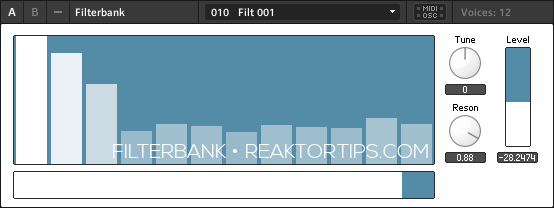I’ve been meaning to make a fixed filter bank in Reaktor ever since I saw a few videos on Youtube of what they could do. They’re a blast for messing with filtered white noise, especially with some modulation and delay effects later in the chain, but they can also add some real character and dimension to instrumental sounds, bringing out tones that a plain old single band filter can’t match.
In this next one the filter bank action starts at around 2:20 –
My version adds one refinement – you can sweep the overall range of the filter up and down to better match your source material and project. Taking a look inside, you can see that there are only two filter modules, but they’re polyphonic, with each voice accounting for one filter band. This makes a neater structure, and one that’s easier to modify.
Front panel controls are tool-tipped and should be self explanatory.
It’s free, and you can get it here:
By the way, please use a real email address not “mrstinky@qwertyuiop.com” because this and Ghost Shift are going to receive updates and I want to notify users when that happens. Apologies to mrstinky if that is in fact a real address.







